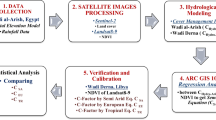Abstract
The construction of stone terraces to minimise soil erosion is common throughout Guizhou. This technique, however, has high inherent risk. Stone terraces are usually much higher than those with earth risers. While they trap a greater thickness of soil on the slope they increase the risk of slope failures, reduce moisture and nutrient availability to plants, and thin more soil up slope. The stone risers also threaten long-term productivity. When a riser collapses debris is deposited over the terrace below making farming difficult. These breaches in the terrace focus surface runoff leading to gully formation and increased sediment transport down slope. Artificial drainage systems, often used in conjunction with terracing, compound the risk. These channels prevent precipitation from soaking into the soil. This limits groudwater and soil moisture recharge which reduces the availablity of water for crops and the length of the growing season. The rapid drainage of water from the slope reduces the time of concentration of the catchment resulting in an increase in flood activity. Floods are caused by smaller rainstorm events. They arrive faster and peak quicker and higher than before the channels were constructed. Engineering solutions to soil erosion must therefore be used in conjunction with, and are not as a substitute for, good land management strategies. Furthermore, despite changes in land use practices, and the application of new technologies, there is a maximum amount of production that can be obtained from this land on a sustainable basis.
Similar content being viewed by others
References
Ash, R.F. and Edmonds, R.L. 1998. China’s land resources, environment and agricultural production [J]. China Quarterly,156: 836–879.
Chenu, C., Le Bissonnais, Y. and Arrouays, D. 2000. Organic matter influence on clay wettability and soil aggregate stability [J]. Soil Science Society of America Journal,64(4): 1479–1486.
Gebremedhin, B.; Swinton, S.M. and Tilahun, Y. 1999. Effects of stone terraces on crop yields and farm profitability: Results of on-farm research in Tigray, northern Ethiopia [J]. Journal of Soil and Water Conservation,54(3): 569–573.
Guerra, A. (1994). The effect of organic matter content on soil erosion in simulated rainfall experiments in W. Sussex, UK [J], Soil Use and Management,10(2): 60–64.
Guizhou People’s Government. Guizhou Yearbook. [Online], available at http://www.gzgov.gov.cn/enggov/pages/yearbook.asp
Hill, R.D. 1993. People, land and and an equilibrium trap: Guizhou Province, China [J]. Pacific Viewpoint,34(1): 1–24.
Li Tianchi. 1989. Landslide: extent and economic significance in China [C]. In: Brabb, E.E. (ed), Landslides, Proceedings of the 28th IGC Symposium, Washington DC, pp 271–287.
Luk, S.H. 1979. Effect of soil properties on erosion by wash and splash [J]. Earth and Surface Processes,4(3): 241–255.
Rozelle, S.; Veeck, G. and Jikun Huang. 1997. The impact of environmental degradation on grain production in China, 1975–1990 [J]. Economic Geography,73(1): 44–66.
Shepherd, T.G.; Dando, J.L.; Saggar, S.; Newman, R.H. and Ross, C.W. 2001. Tillage-induced changes to soil structure and organic carbon fractions in New Zealand soils [J]. Australian Journal of Soil Research,39(3): 465–489.
Shi, P. and Li, W. 1999. Rehabilitation of degraded mountain ecosystems in southwestern China [J]: An integrated approach. Ambio,28(5): 390–397.
Watts, C.W. and Dexter, A.R. 1997. The influence of organic matter in reducing the destablisation of soil by simulated tillage [J]. Soil and Tillage Research,42(4): 253–275.
Young, R.A. and Onstad, C.A. 1982. The effect of soil characteristics on erosion and nutrient loss [C]. In: Walling, D.E. (ed), Recent developments in the explanation and prediction of erosion and sediment yield, Proceedings of the Exeter Symposium, IAHS Publication 137, pp. 105–113.
Zhang Jianping. 1999. Soil erosion in Guizhou province of China: a case study in Bijie prefecture [J]. Soil Use and Management,15(1): 68–70.
Author information
Authors and Affiliations
Corresponding author
Additional information
Biography: McConchie, Jack A. (1956-), male, PhD, Senior Lecturer with the School of Earth Sciences, Victoria University, P.O. Box 600, Wellington, New Zealand
Responsible editor: Chai Ruihai
Rights and permissions
About this article
Cite this article
McConchie, J.A., Huan-cheng, M. A discussion of the risks and benefits of using rock terracing to limit soil erosion in Guizhou Province. Journal of Forestry Research 13, 41–47 (2002). https://doi.org/10.1007/BF02857144
Received:
Issue Date:
DOI: https://doi.org/10.1007/BF02857144




